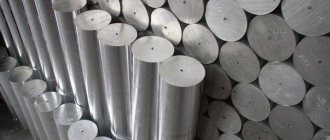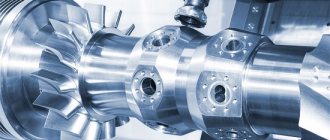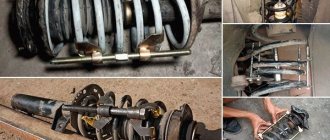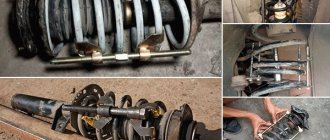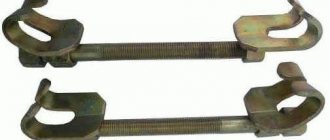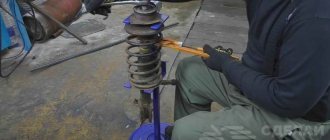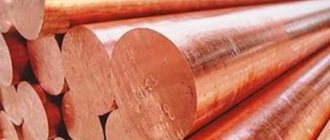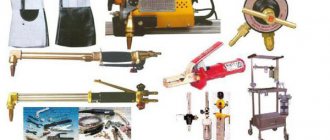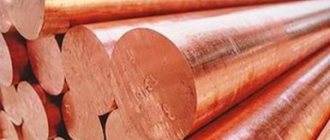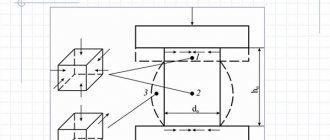Heat treated springs for corrosion protection
Heat treatment of springs is a generalized name for operations such as heating, holding and cooling of these products.
The main goal of such processing is to obtain the specified parameters and properties of elastic products, which is achieved by changing the internal structural structure of the metal alloys used in each specific case. To achieve this goal, steels/alloys are heated to a certain temperature, maintained under such conditions for a precisely specified time and cooled, depending on the technology, in a fast or slow way.
Such processing may be an intermediate operation in the technological process of manufacturing elastic parts, in which case it serves to improve the results of subsequent operations (pressure processing, cutting, etc.). If such processing is the final stage of the technological process, then it is carried out to ensure the specified properties of each product.
Processing of springs and spring materials
In the instrument-making, radio engineering, and mechanical engineering industries, where elastic elements are widely used, electrochemical polishing is used to process flat, spiral, and helical springs. With its help, the elastic characteristics are improved, the durability and reliability of the springs are increased. It was shown above that the combination of thermal and electrochemical treatment in one technological cycle gives the greatest effect in this regard. As a result of thermoelectrochemical treatment of flat springs made of nickel silver 0.3 mm thick, their service life in the product increased by 40-50% before a significant decrease in contact pressure. Beryllium bronze springs for switching signals in the nanovolt range (less than 10-8 V), subjected to the same treatment, did not require adjustment throughout their entire service life, while springs that had not undergone electrochemical polishing were adjusted every few hours. T. e. d.s. in relation to copper of springs that underwent thermoelectric treatment was an order of magnitude lower than when using unpolished springs.
Improving the elastic characteristics of springs is achieved both by processing finished products and by polishing the tape or wire from which they are made. The choice of one or another option is determined taking into account the mass production and the requirements for the products.
When processing cut or wound springs, electrochemical polishing is the final operation. It leads to a reduction in the edge hardening that occurs after cutting, an improvement in the decorative appearance of the surface and an increase in resistance to corrosion. But in this processing option, the process is difficult to automate. Installation and dismantling of springs on hanging fixtures, transfer from one bath to another are associated with the cost of manual labor. Heat treatment in this case is often carried out at another production site, which requires time to transport the parts.
Electrochemical polishing of wire or tape allows for their continuous processing, the labor intensity of which is significantly less than the processing of individual parts. Automatic or semi-automatic lines for such processing include not only polishing baths, but also degreasing, washing, passivating baths, and drying chambers. Polishing the tape improves the subsequent cutting of springs from it - less burrs are formed on the edges, and the durability of the dies increases. The unfavorable role of edge hardening that occurs when cutting springs has any noticeable effect in cases where the springs are thick and the surface, with the exception of the edges along which cutting took place, is small.
It is advisable to use electrochemical polishing for all spring materials - carbon and alloy steels, brass, bronze, nickel silver. A large number of springs are used with electrolytic coatings to increase their resistance to corrosion. As shown above, preliminary electrochemical polishing of the base material reduces the adverse effect that coatings have on the elastic characteristics of springs. When using uncoated springs after anodic polishing, they should be passivated in appropriate solutions.
Under production conditions, for electrochemical polishing of springs made of cold-rolled steel wire grade 50HFA with a diameter of 1.3-1.5 mm and wire grade 4X13 with a diameter of 2.5-3.7 mm, a phosphorus-chromium-sulfate electrolyte was used at a temperature of 80-90 ° C and a current density of 40 - 50 A/dm2.
The springs were previously subjected to heat treatment and etching. Some of the springs were polished in two stages. After the first 2-3 minute treatment, the ends were sharpened and then polished a second time for 5-10 minutes until the required load characteristics were obtained.
The first work on continuous electrochemical polishing of steel spring belts in the domestic industry was carried out in the early 50s, for the needs of watch production, but was not put into practical use. The phosphorus-sulfur-chromic acid electrolyte used required frequent adjustments and periodic complete changes, which increased the cost of processing. As a result of anodic dissolution, not only did the thickness of the tape along the length of the roll not decrease, but sometimes it increased, and surface defects such as scratches, scratches, and cavities were revealed.
Currently, these shortcomings can be largely eliminated. New polishing electrolytes are more stable in operation than conventional phosphorus-chromic acid ones. The proposed methods for regenerating electrolytes for steel polishing with appropriate equipment can be included in a continuous production cycle. When polishing copper alloys, regeneration is not required, since the copper that goes into solution is mainly deposited on the cathode or falls to the bottom of the bath. Using automatic control of current density or strip drawing speed, metal removal can be controlled.
The thermoelectrochemical method for improving the elastic characteristics of springs, which was mentioned above, involves combining heat treatment in one cycle with anodic electrochemical treatment, accompanied by the enrichment of the surface layer of the metal with oxygen. One type of such treatment is electrochemical polishing, if it is carried out under conditions that ensure the achievement of the specified effect. The results of research and experience in the production application of the new method indicate that with its help it is possible to achieve a significant improvement in the characteristics of springs and reduce the labor intensity of production. Considering the mass nature of spring production, it is more technologically advanced and economical to carry out thermoelectrochemical treatment not of individual parts, but of strips or wires, continuously pulling them through a bath system.
The technological process of continuous processing of spring materials consists of the operations of heat treatment, electrical degreasing, electrochemical polishing, passivation, and drying. After each chemical and electrochemical treatment operation, rinsing in water is carried out. A tube furnace is used for heat treatment. High-speed heat treatment is carried out for 15-60 s at the following temperature: nickel silver MNTs15-20 - 475 ° C; BrOF6.5-0.15 and BrA7 - 350° C; BrKMtsZ-1 - 400° C. This heat treatment improves the properties of alloys in the same way as the usually accepted annealing for several hours at a lower temperature, and for springs operating under cyclic loads, it gives a more positive result [81].
For electrochemical polishing of a 0.4 mm thick nickel silver strip MNTs15-20 in a continuous production plant, we initially used an electrolyte containing 1100 g/l H3PO4 and 150 g/l CrO3 at a current density of 50 A/dm2. Under these conditions, good quality of surface treatment of the tape was achieved. But the electrolyte quickly failed due to cathodic reduction of hexavalent chromium ions. The use of porous ceramic diaphragms to insulate the cathode production limited this undesirable process, but at the same time increased the voltage across the bath. The continuous production cycle of the bath made it difficult to adjust the solution and led to the need for frequent changes.
These shortcomings were eliminated as a result of replacing the phosphorochromic acid electrolyte with the phosphoric acid electrolyte we proposed with the addition of organic compounds. The new electrolyte ensured a good quality metal surface, was stable during long-term operation, and did not require frequent adjustments. The need to use diaphragms was also eliminated. Correction of the electrolyte by adding organic compounds was carried out 2-3 times a month during two-shift work. Dissolving copper was deposited on the cathodes and partially fell out to the bottom of the bath. The electrolyte, cleared of sediment, was suitable for further use.
Passivation of the tape after electrochemical polishing was carried out for 0.5-1 min at room temperature in solutions of the following composition: for nickel silver and beryllium bronze - 65 g/l K2Cr2O7, 1.7 g/l H2SO4; for tin phosphorus bronze - 120 g/l K2Cr2O7, 2.5 g/l H2SO4.
Experience in the industrial operation of an installation for continuous thermoelectrochemical processing of spring tape has shown that this process not only improves the elastic characteristics of springs, but also has a very favorable effect on the entire technological process of their manufacture. Previously, due to corrosion and mechanical damage to the surface at the manufacturing plant during transportation and storage, part of the tape was rejected. Electrochemical polishing improved the surface condition and thereby reduced metal loss. The quality of welding of silver contacts to springs has improved. The resistance of springs against corrosion in harsh climatic conditions has significantly increased.
One of the further stages in improving the technology for manufacturing springs is thermoelectrochemical processing of the tape, in which the main contour of the springs is pre-cut so that they are held in the tape at only two or three points. In this case, the influence of edge peening is completely eliminated, and the condition of the entire working surface, including the edges of the springs, is improved. Obviously, such treatment will have an even more positive impact on their performance characteristics.
If necessary, the line for continuous thermoelectrochemical processing of spring tape or wire can be extended to include operations for applying metal coatings.
The combination of thermoelectrochemical processing of the tape with its calibration may be of great interest. Thin strip and sheet products are produced with significant variations in thickness.
Variation in the thickness of the tape under conditions of mass production of springs is one of the reasons for the decrease and instability of their elastic characteristics. Narrowing the tolerance on material thickness requires additional operations and the use of special metallurgical equipment.
By adjusting the rate of metal dissolution, it is possible to significantly reduce the initial variation in thickness of the material. To do this, at the inlet and outlet of the tape from the anodic treatment bath, sensors for continuous monitoring of metal thickness with feedback must be included in the line, providing regulation of the current density or the speed of pulling the tape.
With high sensor accuracy and circuit reliability, a combination of electrochemical polishing and metal calibration becomes realistic.
The presented materials on the use of electrochemical polishing in the production of springs are an example of how this process can simultaneously have a beneficial effect on various properties of parts and significantly change the entire technology of their manufacture.
Types of springs
Springs are elastic parts, mainly used in industries such as mining, oil and gas, energy, mechanical engineering and machine tools, and others.
The most common types of them are:
- - Sprains. Under axial load, their length increases, whereas in the initial state the coils are in contact. They experience torsional and bending stresses.
- - Compression. Under axial load, their length decreases; in the initial state, the turns are located at a pitch distance (determined depending on the specifics of the application). They also experience torsional and bending stresses.
- — Torsion - the load is applied in a plane that is perpendicular to the axis of the product. They work to twist and exert a turning moment of force.
- - Bend. By slightly deforming, they can transmit great force.
What qualities are required from springs?
These components are subject to special requirements, which is due to their importance for the efficient and trouble-free operation of the entire device, instrument, or unit. Their main quality is the ability to deform (change their size) under the influence of externally applied load and restore their original shape and size when the external influence stops. During deformation, energy is accumulated, and when it returns to the initial state, it is transferred.
Important characteristics of elastic elements:
- — Strength under load, which can be static, dynamic, cyclic.
- - Good plasticity.
- - Endurance.
- — Significant elastic limit.
- - Relaxation resistance.
From a technological point of view, such parameters as deep hardenability, low ability for decarburization and growth of structure grains during heat treatment are important. In addition, the sensitivity to temper brittleness and the critical hardening rate should be low.
With all the variety of types of springs and cases of their use, each of these parts requires guaranteed recovery after the load is removed; this determines the features of their operation and, accordingly, manufacturing.
Heat treatment is precisely intended to preserve the shape and elastic properties of the springs throughout the design service life.
Materials used
High demands are placed on the production of springs, starting with the selection of a material whose characteristics would meet certain requirements.
Accordingly, it is important how these materials will behave in processing, including thermal processing.
For large springs (made from a rod of 8 mm in diameter), the most commonly used are structural spring steel 60S2A, 50KhFA, 51KhFA, 60S2KhFA GOST 14959-79 and other similar alloys.
For small (up to 8 mm diameter) - steel 60S2A GOST 14959-79, wire B-2 GOST 9389-75, any wire according to GOST 9389-75 grades A, B, B classes 1,2,3 and other similar alloys.
For work in aggressive environments, stainless steels 08Х18Н10Т, 10Х18Н10Т, 12Х18Н10Т are used.
Types of heat treatment
The main types of heat treatment of metals/alloys used in the production of springs include:
- — Annealing - products are heated to a temperature corresponding to the transformation range, maintained in this state for a certain time and slowly cooled along with the furnace. Improves the structure of the metal, increases viscosity, while slightly reducing hardness.
- — Normalization - products are heated to the austenitic state (the temperature exceeds the corresponding transformation range), after which they are cooled naturally in air. Helps improve structure, increase mechanical parameters and level internal stresses.
- - Quenching - heating is carried out to a temperature corresponding to the transformation range or slightly higher, they are kept in this state for some time, then cooled quickly, mainly in oil, although it is possible in another environment. Provides the metal with high strength properties, good hardness and wear resistance. However, it also increases brittleness, the inability to withstand shock loads and bending, so it is usually tempered after it.
- — Tempering - low, medium, high - heating to a temperature below the corresponding transformation range (up to 250 degrees, 350-500 degrees and 500-680 degrees), remaining in this state for some time and then cooling. Increases viscosity, plasticity, relieves residual stresses, improves performance, and slightly reduces strength.
- — Aging – can be natural (long exposure under normal conditions) or artificial (short exposure at low temperature heating). Helps stabilize geometric dimensions and spring properties.
- — Capturing – cold or hot – holding under load at normal temperature or in a hot oven (for springs used at high temperatures). Increases the elastic limit, safety margin, reduces the level of maximum stresses during operation. This is always the final operation, after which no heat treatment is allowed.
Requirements for wire and its diameter
Steel wire for the manufacture of a spring, which will subsequently be hardened, must meet the requirements specified in GOST 14963-78. According to the document, it is classified according to the following criteria:
- winding method (cold and hot);
- method of surface finishing (without finishing and with finishing);
- manufacturing accuracy (normal and increased);
- class of mechanical properties (general and critical use);
- diameter (from 0.5 to 14 mm);
- type of delivery (in rods or coils).
At industrial enterprises, springs are made from wire with a diameter of no more than 16 mm using the cold winding method, and up to 80 mm using the hot method. In production, they are wound using a rotating mandrel, feed rollers and one or two stop pins.
Products are made from wire grades 51ХВА, 70С3А, 65С2ВА, 60С2А, 65Г, 60ХВА with a ground, polished surface or without grinding and polishing. Based on this characteristic and the manufacturing method, the wire is produced in rods or coils of the following groups:
- A, B, C, D, E – with special finishing;
- N - without finishing.
The wire symbol in the technical documentation and on accompanying tags consists of numbers and letters:
ХХХХХ (1) – Х (2) – Х (3) – Х (4) – ХХ (5) – ХХ (6) GOST 14963-78 (7)
Where:
- 1 – steel grade;
- 2 – surface finishing method;
- 3 – manufacturing accuracy;
- 4 — class of mechanical accuracy;
- 5 - winding method;
- 6 - diameter in mm;
- 7 - designation of the standard.
For example, a wire with a polished surface made of high-precision class I steel 60C2A for hot coil springs with a diameter of 2.0 mm will have the following designation:
60S2A – A – P – I – GN – 2.0 GOST 14963-78
The state standard specifies permissible maximum deviations, out-of-roundness and the inadmissibility of certain types of defects, as well as methods of packaging and transportation.
Physical basis of heat treatment
Heating and cooling of metal/alloy springs are accompanied by phase transformations, during which the structure of the material and characteristics important for the operation of the product change.
Heating should be treated very responsibly, since with an increase in temperature and time of its exposure, in particular, the intensity of oxidation of the surface of products increases, which leads to the formation of scale.
Overheating leads to the metal acquiring a coarse-grained structure and reducing ductility; further heating is dangerous due to burnout - and this is an irreparable defect.
Features of the use of types of heat treatment
What type and modes of heat treatment are assigned in a particular case is determined by the grade of steel/alloy used, the size of the spring and the profile of the workpiece, the nature and operating conditions of the finished product.
The most common heat treatment option for springs is oil quenching followed by tempering. If the original steel has a large grain, normalization is first performed.
The springs are heated for hardening while lying down so that they do not sag under their own weight. For some standard sizes, special mandrels can be used to avoid product bending; for tension springs, the coils must be clamped or tied. The quenching temperature depends on the grade of steel/alloy used, for example, for 60S2A it is 870 degrees, and for 50HFA and 60S2HFA it is 850 degrees, and the parts must be immersed vertically in the quenching liquid to avoid warping.
Next, a vacation is carried out when the temperature reaches 420 degrees for 60C2A, up to 450 degrees for 50HFA, and up to 470 degrees for 60S2HFA.
Small and medium coil springs, for the manufacture of which patented wire is used, are subjected to tempering only. Patenting carried out by the manufacturer is heating to a temperature slightly higher than the transformation range. Thus, the metal is well prepared to accept cold plastic deformation. Tempering is carried out to eliminate internal stresses that appeared during the winding process. To do this, heat up to 200-250 degrees, the duration of exposure to this temperature is 20 minutes.
Materials. Making springs
0
Materials. Making springs
Springs are made from carbon and alloy steels with a carbon content of 0.5-1.1%. Springs with a wire diameter of up to 10 mm are made from carbon steel; from alloy steels - springs operating at high voltages or elevated temperatures, as well as springs with large wire sections (20-30 mm in diameter) to ensure hardening to the full cross-section.
Silicon additive (up to 2%) increases the elastic properties of steel and resistance to repeated impact loads. Vanadium (0.1-0.2%) and tungsten (up to 1.2%) are introduced to increase mechanical properties and heat resistance. For critical springs, tungsten-silicon and chromium-silicon-vanadium steels are used, which have the highest mechanical properties.
Springs operating at elevated temperatures are made from chrome vanadium steel type 50HFA (heat resistance up to 300°C), tungsten-silicon steel type 65S2VA (up to 350°C) and steel 40X13 (up to 450°C).
For springs operating at temperatures above 500°C, special steels with a high content of Cr, V, Mo, W are used.
In table 57 shows the main materials used for the manufacture of springs and their mechanical properties after heat treatment. Elastic modulus of spring steels E = (2.1–2.2) 105 MPa, shear modulus G = (7.6–8.2) 104 MPa.
The fatigue resistance of spring steels depends little on the chemical composition and is largely determined by the state of the surface layer. Decarburization of the surface layer during heat treatment, local defects (corrosion, nicks, scratches, abrasion during wear) sharply reduce the endurance limit. A significant increase in fatigue resistance can be achieved by polishing and especially cold-hardening of the surface layer (drawing, shot blasting).
The endurance limit under zero cyclic loading averages 400–600 MPa.
The strength of spring steels is very dependent on the diameter of the wire, increasing sharply with decreasing diameter. As an example in Fig. 856 shows the strength indicators of cold-rolled wire as a function of diameter. The strength of small diameter wire (0.2-1 mm) is approximately twice that of large diameter wire (8 mm). The diameter of the wire should be taken into account when choosing permissible stresses when calculating springs.
For the manufacture of springs operating in conditions of high humidity or in contact with chemically aggressive media, corrosion-resistant steel 40X13 or copper-based alloys are used. In table 58 shows the most commonly used copper alloys and their mechanical properties.
Elastic modulus of copper-based alloys E = (1.2-1.3) 105, shear modulus G = (4.5-5) 104 MPa.
Beryllium bronzes have the highest anti-corrosion properties and the greatest fatigue resistance. The combination of these properties with high electrical conductivity determines the widespread use of beryllium bronzes for the manufacture of springs in electrical engineering. In addition, beryllium bronzes are characterized by high constancy of elastic properties and an almost complete absence of hysteresis, and for this reason they are often used for the manufacture of elastic elements of precision instruments.
Springs made of copper-based alloys are paramagnetic and are used in cases where it is necessary to eliminate the influence of magnetic fields.
Spiral springs made of small diameter wire (up to 10 mm) with a ratio D/d>4 (D is the average diameter of the spring; d is the diameter of the wire) are produced by cold coiling. Springs with a ratio D/d<4, as well as springs made from wire of large sections, are wound hot.
With cold winding, two options are possible:
1) the wire is wound in a heat-treated state or after cold drawing and after winding is subjected to a low tempering (200-300°C) to relieve stresses arising during winding;
2) the wire is wound in an annealed state and, after winding, is subjected to quenching and tempering.
According to the first method, springs are made from carbon steels, for example, from piano wire and cold-rolled wire with a diameter of 0.2-8 mm, as well as from silicon-tungsten and chrome-vanadium steels.
Piano (patented) wire is made from high-quality high-carbon steel (~ 1% C) and subjected to isothermal hardening (heating to 870-950°C) followed by exposure to molten lead up to 500°C (patenting). After heat treatment, the wire is subjected to gauge drawing; As a result of cold hardening, the wire acquires exceptionally high strength (up to σв = 3000 MPa).
Springs are similarly made from cold-rolled wire, which is produced in three strength classes: normal H, high P and high B, divided into groups I-II (for classes H and B) and I-III (for class P), depending on the viscosity.
Alloy steels (with the exception of silicon-tungsten and chrome-vanadium steels) are subjected to heat treatment after coiling: quenching in oil at 800-850°C and subsequent medium tempering at 400-500°C.
To avoid decarburization of the surface layer, heating for hardening is carried out under a layer of charcoal powder or cast iron filings. Heat treatment modes are developed in detail for each steel grade and are subject to strict adherence in order to obtain the highest strength values.
Springs wound in a hot state are subjected to mandatory heat treatment after winding. Winding is carried out at 800-1000°C.
Springs made of BrO4TsZ and BrKZMts1 bronzes are wound in the delivery state and, after winding, are heated to 100–150°C to relieve stress. Springs made of beryllium bronzes are quenched in water at 800°C, and then tempered at 250-350°C.
Steel springs for critical purposes, operating under cyclic load conditions, are subjected to shot blasting after heat treatment.
The final step in spring manufacturing is the application of a coating to prevent corrosion. Steel springs are usually galvanized, cadmium-plated, nickel-plated, chrome-plated, phosphated, etc.
Corrosion protection
To protect springs from corrosion, which, due to operating conditions, will be in aggressive environments, various methods are used. The most common of them:
- — Chrome plating;
- — Cadmium plating;
- — Galvanic galvanizing;
- — Chemical oxidation and oiling;
- - Paintwork;
- — Polymer powder coating.
The purpose of applying any of them is to protect the product from corrosion and other consequences of adverse environmental influences, which can lead to loss of operating efficiency and a sharp reduction in service life.
